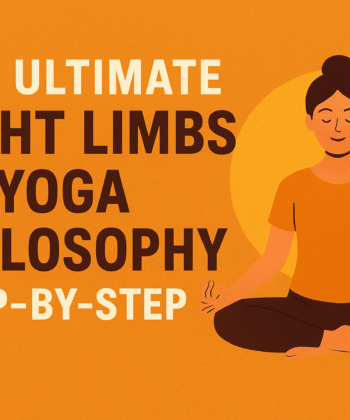
Table of Contents
Why is Kundalini Yoga dangerous? I mean, think about it…a dormant snake coiled at the base of your spine just waiting to spring to life. That’s the image yogis use, and for good reason: when that energy stirs, it can hit you like a tidal wave. I’ve seen people light up with clarity and bliss, but I’ve also heard stories of overwhelm and unexpected side effects. It’s powerful stuff…and if you treat it like “just another stretch-and-breathe routine,” you could be in for a rough ride. Stick around, and I’ll show you exactly what makes Kundalini Yoga so potent, and how to approach it with the respect (and safeguards) it deserves.
Kundalini Yoga isn’t just exercise, it’s an awakening
It’s about stirring the powerful force resting at the base of your spine and guiding it upward through breath, movement, mantra, and meditation. This isn’t just about poses; it’s a spiritual practice that unlocks intuition, expands awareness, and connects you to a higher state of being. Real awakening calls for patience, respect, and preparedness.
Why Is Kundalini Yoga Dangerous?
Well, Kundalini Yoga is often called the most powerful form of yoga, but it’s also seen as the most dangerous. And honestly, it makes sense. Anything with the power to completely transform you also has the potential to overwhelm you if it’s not handled properly.
Think of it like this: producing energy through a nuclear reactor is one of the most efficient methods we know, right? But it’s also incredibly risky if things go wrong. The same idea applies here. Why Is Kundalini Yoga Dangerous? Because it’s the most potent form of yoga and when something is that powerful, it demands serious care and preparation.
The problem is, a lot of people read a few books or watch a couple of videos and think they can jump straight into advanced Kundalini practices. Instead of starting with the basics, they want to go straight to the most profound experiences. But in reality, this attitude can be really risky. Why Is Kundalini Yoga Dangerous? Because trying to force an awakening without the right guidance can cause physical, emotional, and mental disturbances that are hard to control.
In traditional yoga, there’s a reason why different practices are taught to different kinds of people. For someone living a regular family life, certain powerful practices are never recommended, they simply demand a level of discipline, time, and focus that modern life doesn’t usually allow. If you push too hard with Kundalini Yoga without setting up the right foundation, it can actually break down your outer life relationships, work, everything before you’re even ready for it.
Now, don’t get me wrong, there’s absolutely nothing wrong with Kundalini Yoga itself. It’s an amazing and transformative process when done correctly. But energy doesn’t think for you. It doesn’t decide whether it’s helping or harming…that’s up to you. Why Is Kundalini Yoga Dangerous? Because the energy will amplify whatever state you’re already in. With the right use, it can help you reach new heights. Handled carelessly, it can burn you out.
Just like electricity lights up our homes but if you mishandle it, it can hurt you…Kundalini energy is powerful, neutral, and needs to be respected. So, if you’re wondering again, Why Is Kundalini Yoga Dangerous?, the real answer is: it’s not dangerous when approached with proper preparation, patience, and expert guidance. But absolutely, it can be without it.
Real Risks Backed by Experts
You might be wondering, why is Kundalini Yoga dangerous, especially when so many people talk about its powerful benefits. Well, here’s the honest truth: Kundalini Yoga isn’t dangerous when approached carefully, but it can cause real risks if practiced without the right preparation, support, or understanding.
Experts and experienced teachers agree that awakening the Kundalini energy can be incredibly transformative…but it’s also intense. Without proper guidance, it’s easy to run into problems both mentally and physically.
Psychological Effects:
Many therapists and yoga scholars point out that intense breathwork and deep meditation (both key parts of Kundalini Yoga) can trigger sudden emotional outbursts, deep anxiety, confusion, or even resurfaced past traumas. If your energy rises faster than your mind and body can handle, it can leave you feeling overwhelmed rather than enlightened. This is a major reason people ask, “Why is Kundalini Yoga dangerous?”
Physical Sensations:
Experts also note that sudden physical symptoms like heat surges, uncontrollable shaking, dizziness, or fatigue can happen when Kundalini energy starts to move. These aren’t “bad” signs, but if you’re not prepared or grounded, they can be scary and destabilizing.

Energy Overload:
One of the real risks of Kundalini awakening is an energy overload where too much spiritual energy floods your system all at once. Without the right techniques to balance and ground yourself, this can make you feel hypersensitive, disoriented, or emotionally raw.
Scientific Insights:
Modern neuroscience backs some of these concerns. Studies show that intense meditation and breathwork can literally rewire the brain, changing how we process emotions and stress. While these changes can be positive over time, going too fast without emotional readiness can cause confusion, emotional flooding, or even panic attacks for some people.
That’s why most experienced Kundalini Yoga teachers (especially those certified by Yoga Alliance or similar organizations) emphasize starting slowly, building strong foundations, and always listening to your body and mind.
Kundalini Yoga: Myths You Should Stop Believing
There’s a lot of mystery (and let’s be honest, a little fear) floating around Kundalini Yoga. If you’ve ever Googled “Why is Kundalini Yoga dangerous,” you’ve probably seen some wild claims! Let’s get down to the facts and clear up some common misconceptions to clear any doubts.
Myth 1: Kundalini Yoga Is Dangerous and Might Make You Crazy
Reality:
When practiced with care and under guidance, Kundalini Yoga is completely safe. There’s no scientific proof that it leads to insanity or harm. The key is respecting the process, not rushing into advanced practices without preparation.
Myth 2: It’s a Religion or Cult
Reality:
Nope! Kundalini Yoga is not associated with any particular religion. It’s about tuning into your inner energy and growing spiritually, no matter what you believe. People from all faiths (or no faith at all) practice it.
Myth 3: Awakening Kundalini Feels Terrifying
Reality:
Most individuals say it is incredibly peaceful, relaxing, and even joyful. Fear usually comes from the unknown not the experience itself. With the right mindset, the awakening is something beautiful, not scary.
Myth 4: You Must Wear a Turban or Head Covering
Reality:
You might see some practitioners wearing head coverings, but it’s not a rule. It’s just a personal choice some make to help with focus and energy flow. Totally optional!
Myth 5: It’s All About Sexual Energy
Reality:
Yes, Kundalini energy rises from the base of the spine, but it’s about awakening your full life force, not just sexual energy. It’s about healing, awareness, and a deeper connection with yourself and the world.
Myth 6: It Will Damage Your Relationships
Reality:
Actually, many people find that as they grow through Kundalini Yoga, their relationships improve. When you become more balanced, grounded, and joyful, it naturally affects how you connect with others (in a good way).
How to Practice Kundalini Yoga Safely
If you’ve been wondering why is Kundalini Yoga dangerous, a few simple precautions can keep your practice both powerful and protected:

- Begin Gently: Start with basic breathwork and simple kriyas to build strength and awareness slowly.
- Ground Before & After: Incorporate grounding poses (like Child’s Pose or Mountain Pose) to help your energy settle
- Listen to Your Body: Pause if you notice unusual heat, shaking, or sudden emotions…then return with a lighter practice.
- Stay Connected: Whenever possible, practice under the guidance of a certified teacher or supportive community.
By following these steps, you’ll honor the potency of Kundalini Yoga while avoiding the most common pitfalls.
So, here’s the bottom line
Kundalini Yoga isn’t some spooky, evil practice…it’s more like electricity.Your entire universe can be illuminated by carefully pressing a switch. Rush in or misuse it, and you risk getting burned.
The secret? Treat it with respect. Start slow, ground yourself, and learn from someone who knows the ropes. If you haven’t yet, take a look at our step-by-step guide on How to Practice Kundalini Yoga at Home for more details.
Now it’s your turn. What was your first Kundalini experience like? Or what questions do you still have? Please share your thoughts in the comments section below and let’s continue the discussion!
Also Read: 5 Erector Spinae Exercises to Strengthen Your Lower Back at Home
Also Read: What are the 3 Gunas in Hinduism?
Also Read: How to Practice Kundalini Yoga at Home




